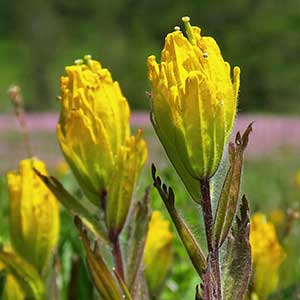Castilleja levisecta
Castilleja pallescens
golden Indian paintbrush, golden paintbrush
dwarf pale paintbrush, pale Indian paintbrush, pale paintbrush
few to many, erect, ± decumbent or creeping at base, unbranched, sometimes branched, hairs spreading, medium length and long, soft, mixed with short stipitate-glandular ones.
few to many, erect to ascending, decumbent at base, unbranched, sometimes branched, hairs moderately to very dense, retrorsely curved to appressed, short, ± stiff, eglandular.
green to purple or brown-tinged, linear-lanceolate proximally, oblong-ovate or -obovate distally, 0.8–5.2 cm, not fleshy, margins plane, distalmost sometimes ± wavy, involute, 3–7(–11)-lobed, apex obtuse;
lobes erect to ascending, linear to linear-spatulate, very short, toothlike, usually arising from distal 1/3 of blade, apex rounded.
purple-tinged or deep purple, sometimes green, linear to narrowly lanceolate, 1–4(–5) cm, not fleshy, margins plane, sometimes ± wavy, ± involute, (0–)3–5(–7)-lobed, apex acute;
lobes spreading or ascending-spreading, linear, apex acute.
2.5–25 × 1–4 cm;
bracts bright yellow throughout, or proximally greenish, distally bright yellow, sometimes deep yellow-orange, especially with age, oblong, elliptic, or obtuse to ovate, (0–)5–9(–13)-lobed, sometimes wavy-margined;
lobes erect to ascending, oblong, short to medium length, arising above mid length, central lobe apex rounded, lateral ones rounded to acute.
(1.5–)4–8(–12) × 1.5–5.5 cm;
bracts pale green to yellow-green or reddish purple throughout, or proximally pale green to yellow-green, distally white to cream or pale yellowish, sometimes pink to reddish purple, lanceolate to linear-lanceolate, elliptic, or ovate, 3–5(–9)-lobed;
lobes spreading to ascending, linear, long, arising along distal 2/3, apex acute to obtuse.
straight or slightly curved, 17–28 mm;
tube 12–15 mm;
beak exserted, adaxially green or greenish yellow, 6–8 mm;
abaxial lip yellow or greenish, reduced, not inflated, 2–3 mm, 25–33(–50)% as long as beak;
teeth ascending to erect, yellow, 0.5–1.5 mm.
straight, 13–23(–27) mm;
tube 10–20 mm; subequal to calyx or beak slightly exserted;
beak adaxially whitish or buff, rarely pink to pink-purple, 3.5–8 mm;
abaxial lip proximally green, white, purple, or purplish brown, distally white, yellow, green, pink, or reddish, prominent, pouched, pouches pleated, longer than deep, gradually expanded, 2.5–8 mm, 70–100% as long as beak, puberulent;
teeth erect to spreading, pink, cream, or white, sometimes with a yellow spot proximally, 1.5–3.5 mm.
distally yellow, 13–22 mm;
abaxial and adaxial clefts 4–9.5 mm, 30–40% of calyx length, deeper than laterals, lateral 2.5–4.5 mm, ca. 25% of calyx length;
lobes linear to narrowly oblong or narrowly lanceolate, apex obtuse, sometimes rounded to acute.
colored as bracts, sometimes distally purple with age, 11–25(–27) mm;
abaxial and adaxial clefts 7–13.6 mm, 40–50% of calyx length, deeper than laterals, lateral 0.5–4.3(–6) mm, (0–)5–25% of calyx length;
lobes lanceolate to triangular, apex usually triangular or acute, rarely ± obtuse.
= 24.
= 24, 48.
Castilleja levisecta
Castilleja pallescens
Castilleja levisecta is listed as threatened in the United States and endangered in Canada, where it is extremely rare. Most of its grassland habitat has been altered by development in the Puget Trough, and there are historical stations in the metro areas of what are now Victoria, Portland, and Seattle. For several decades, C. levisecta was considered extirpated from Oregon. However, recent reintroduction programs in Oregon and Washington have been very successful at reestablishing this species at several sites in the Willamette Valley. The bright yellow inflorescences often gradually age to a golden yellow color, unique in the genus.
Castilleja levisecta is in the Center for Plant Conservation’s National Collection of Endangered Plants.
(Discussion copyrighted by Flora of North America; reprinted with permission.)
Varieties 2 (2 in the flora).
Castilleja pallescens occurs from valleys to alpine ridges and summits throughout its range, usually in sagebrush communities, but at higher elevations it is also found on dry sites associated with other plant species. The alpine plants are greatly reduced in stature.
(Discussion copyrighted by Flora of North America; reprinted with permission.)
1. Bracts not rigid, veins inconspicuous, usually same color as surfaces; herbs (0.5–)1–3 dm; ne Idaho, sw Montana, nw Wyoming. | var. pallescens |
1. Bracts rigid, veins prominent, pale and contrasting with color of surfaces; herbs 0.4–1.2(–1.7) dm; s, se Idaho, ne Nevada, Oregon. | var. inverta |


